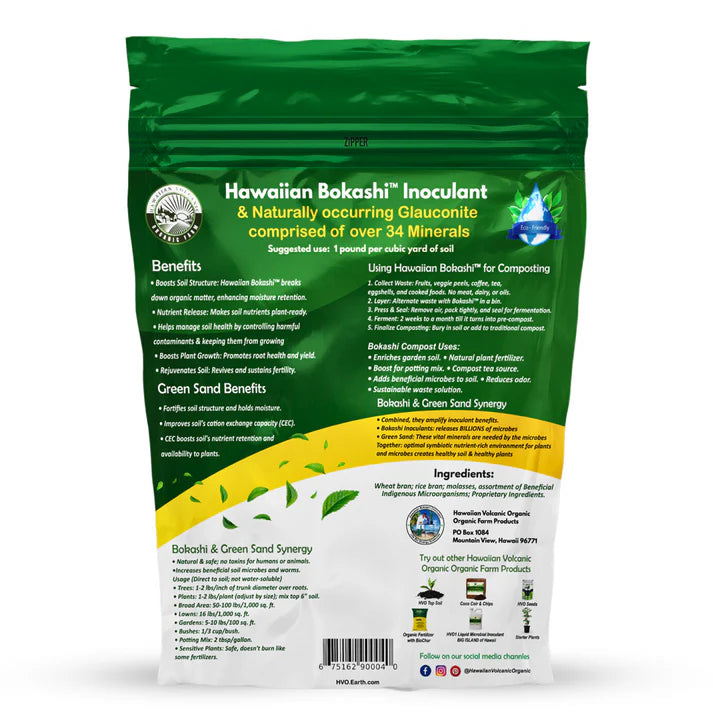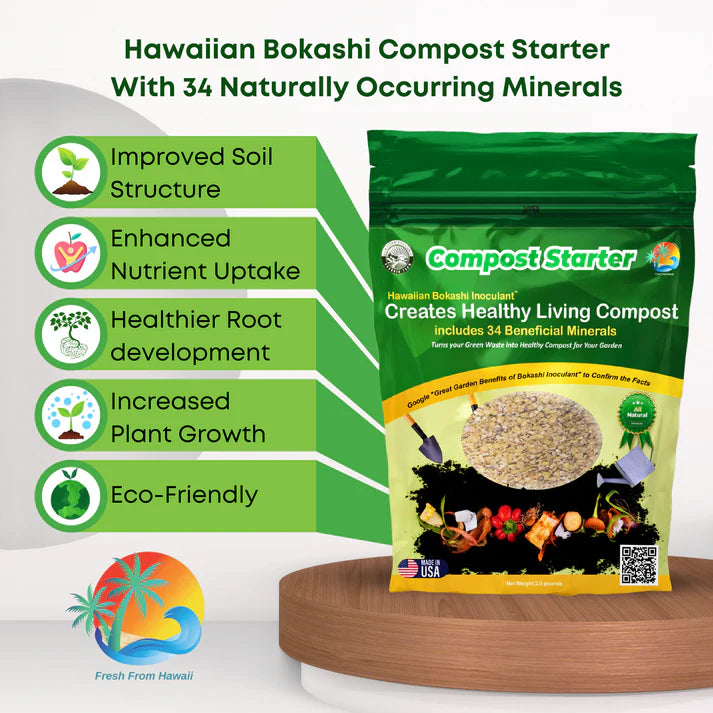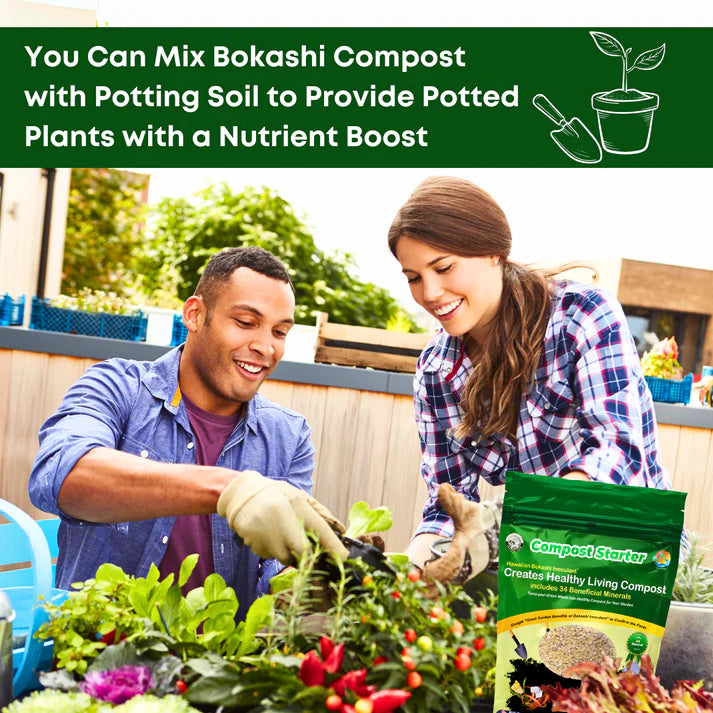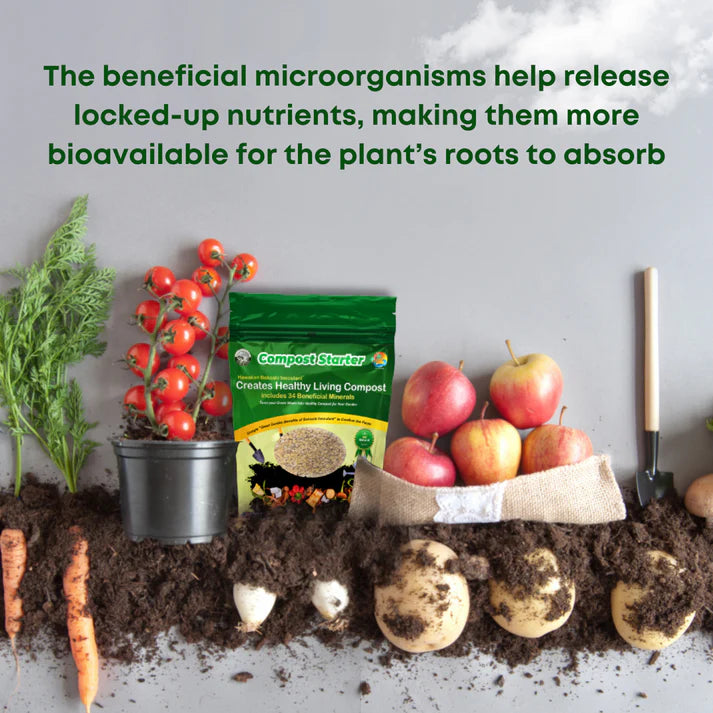Hawaiian Volcanic Organic
Hawaiian Bokashi Compost Starter with 34 Naturally Occurring Minerals
Hawaiian Bokashi Compost Starter with 34 Naturally Occurring Minerals
Couldn't load pickup availability
Overview: Use 1 Pound Per 1 Cubic Yard Of Soil For Gardens And Grow Beds.
- Weight: 2.0 pounds
- 34 Naturally Occurring Minerals
Share
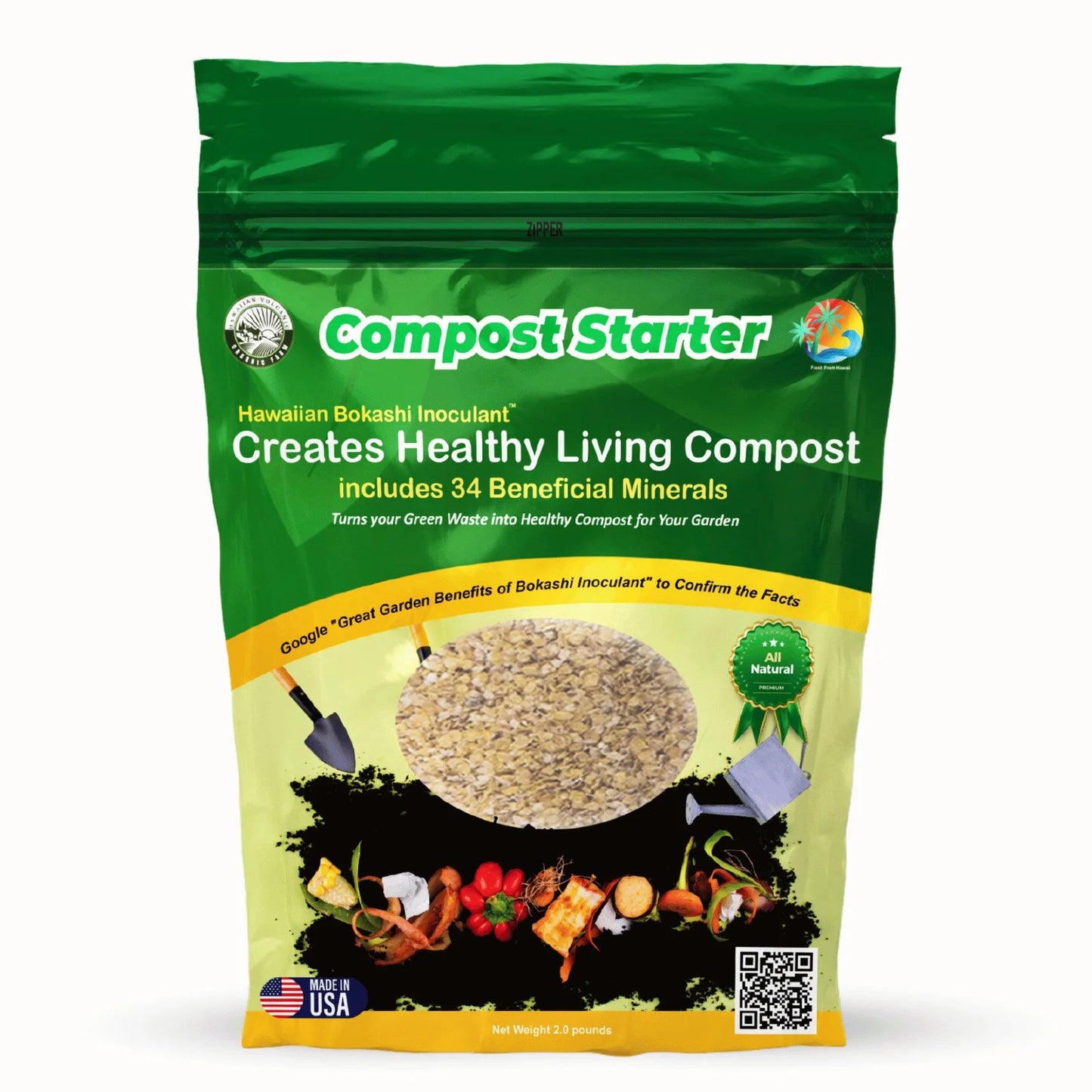
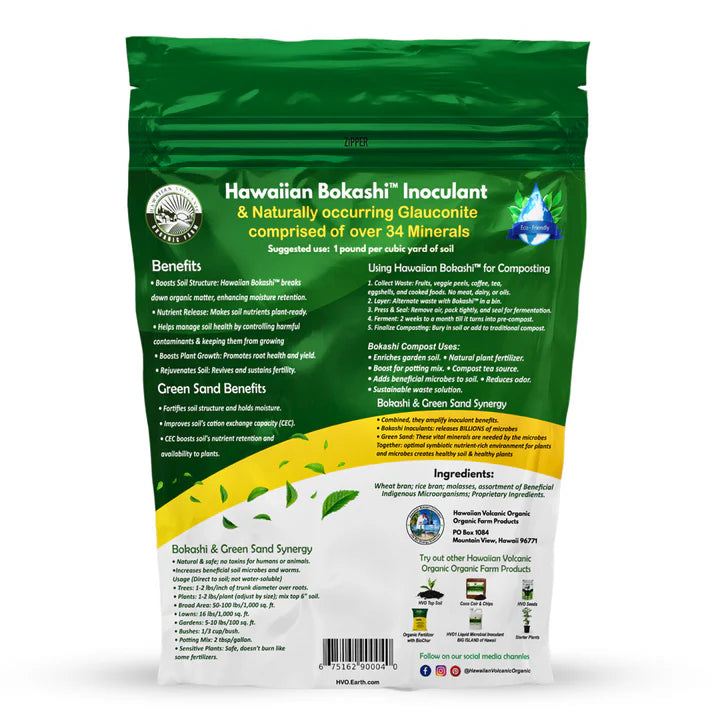
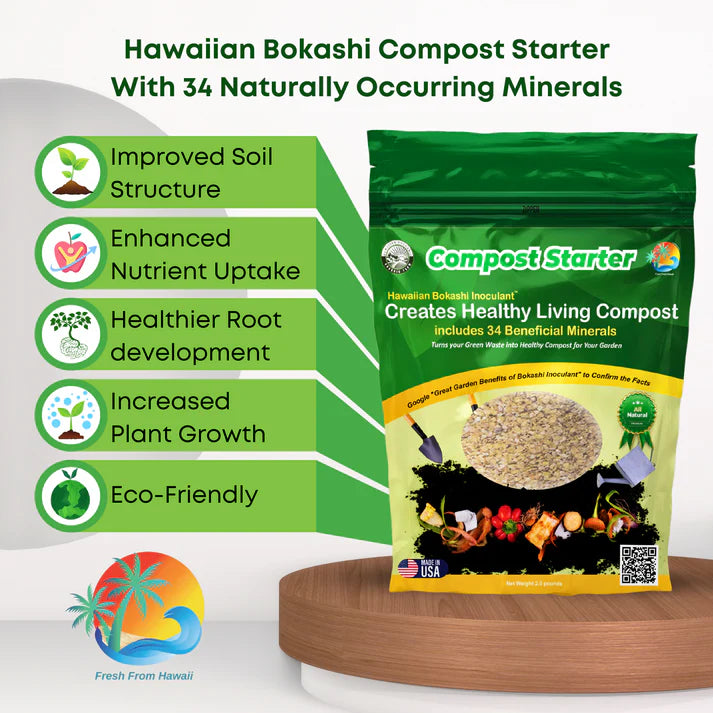

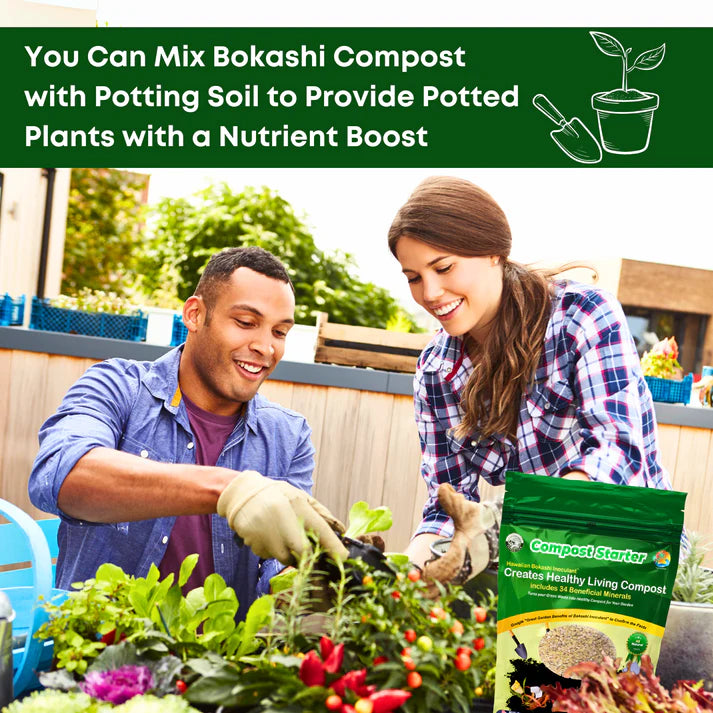
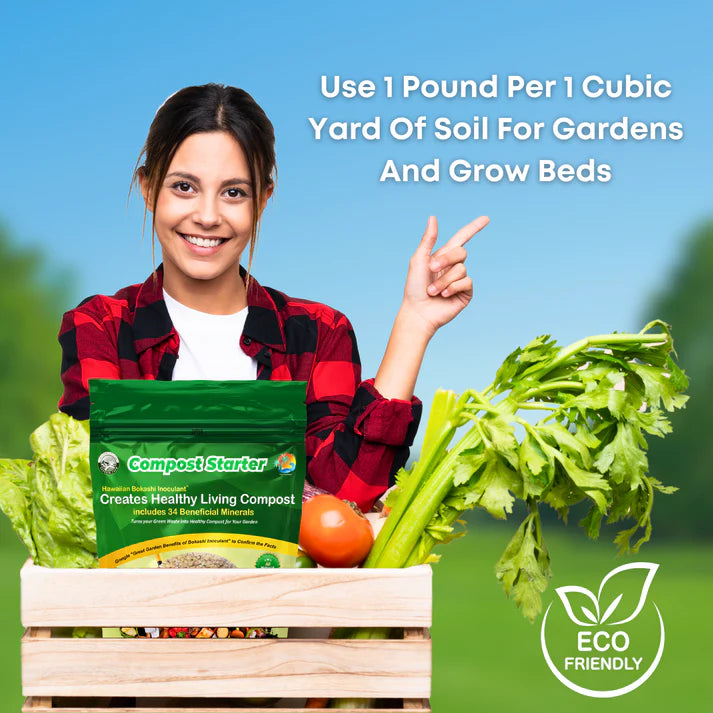

What 34 minerals are in our Compost Starter
Green sand, also known as glauconite, is a mineral-rich substance often used as a soil amendment in gardening and agriculture. It is known for its high mineral content, which can improve soil fertility and structure. Here are 34 minerals commonly found in green sand and their benefits to the soil
-

Silicon (Si)
- Enhances plant strength and resistance to pests and diseases.
- Improves soil structure and aeration.
-

Potassium (K)
- Essential for plant growth and development.
- Enhances drought resistance and improves fruit quality.
-

Iron (Fe)
- Vital for chlorophyll production and photosynthesis.
- Promotes healthy green foliage.
-

Magnesium (Mg)
- Crucial for photosynthesis as it is a central component of chlorophyll.
- Aids in enzyme activation and nutrient uptake.
-

Calcium (Ca)
- Strengthens plant cell walls and aids in root development.
- Helps maintain soil pH and improve soil structure.
-

Phosphorus (P)
- Important for energy transfer and photosynthesis.
- Promotes root development and flowering.
-

Manganese (Mn)
- Involved in photosynthesis, nitrogen metabolism, and synthesis of certain enzymes.
- Improves resistance to environmental stress.
-

Copper (Cu)
- Essential for photosynthesis and enzyme activation.
- Aids in lignin synthesis, which strengthens plant tissues.
-

Zinc (Zn)
- Necessary for enzyme function and growth regulation.
- Helps in the synthesis of plant hormones and proteins.
-

Boron (B)
- Vital for cell wall formation and reproductive development.
- Enhances nutrient and water uptake.
-

Molybdenum (Mo)
- Important for nitrogen fixation and nitrate reduction.
- Aids in the synthesis of amino acids and proteins.
-

Sodium (Na)
- Helps in the regulation of osmotic balance in plants.
- Can enhance stress tolerance in certain conditions.
-

Sulfur (S)
- Essential for protein synthesis and enzyme function.
- Improves soil structure and fertility.
-

Nickel (Ni)
- Required for nitrogen metabolism.
- Involved in the activation of certain enzymes.
-

Cobalt (Co)
- Important for nitrogen fixation in legumes.
- Aids in the synthesis of certain vitamins.
-

Chlorine (Cl)
- Essential for photosynthesis and osmoregulation.
- Helps in stomatal opening and closing.
-

Vanadium (V)
- Can enhance nitrogen fixation in plants.
- May aid in the development of certain enzymes.
-

Selenium (Se)
- Acts as an antioxidant and can improve plant stress resistance.
- Involved in certain metabolic processes.
-

Aluminum (Al)
- While not essential, it can influence soil pH and structure.
- In small amounts, it can benefit plant root development.
-

Lithium (Li)
- Can stimulate plant growth and stress tolerance.
- May influence certain enzyme activities.
-

Titanium (Ti)
- May enhance plant growth and development.
- Involved in certain metabolic pathways.
-

Barium (Ba)
- Not essential but can be present in trace amounts.
- May influence soil structure.
-

Strontium (Sr)
- Present in trace amounts and can influence plant growth.
- May affect calcium uptake
-

Rubidium (Rb)
- Can substitute potassium in some plant functions.
- Influences enzyme activity and nutrient transport.
-

Gallium (Ga)
- Trace element that may influence plant growth
- Can affect certain metabolic processes.
-

Germanium (Ge)
- In trace amounts, it may enhance plant growth.
- Acts as a semiconductor in biological processes.
-

Arsenic (As)
- While generally toxic, in very low concentrations, it can influence plant metabolism.
- Affects certain enzyme functions.
-

Cadmium (Cd)
- Typically toxic, but trace amounts can be found in soil amendments.
- Affects nutrient absorption and metabolism.
-

Lead (Pb)
- Generally toxic, but trace amounts can be present.
- Influences soil chemistry and structure.
-

Thorium (Th)
- Present in trace amounts and can influence soil properties
- Affects mineral availability.
-

Uranium (U)
- Found in very low concentrations, can affect soil properties.
- Influences certain mineral cycles.
-

Yttrium (Y)
- Rare earth element that can influence plant growth.
- Affects certain metabolic pathways.
-

Zirconium (Zr)
- Present in trace amounts and can influence plant growth.
- Involved in certain structural functions.
-

Lanthanum (La)
- Rare earth element that can enhance plant growth.
- Affects enzyme activity and nutrient uptake.
This information is provided for educational purposes and should not be considered a health claim. Green sand is not an FDA-registered product, and its benefits are based on traditional agricultural practices and soil science.
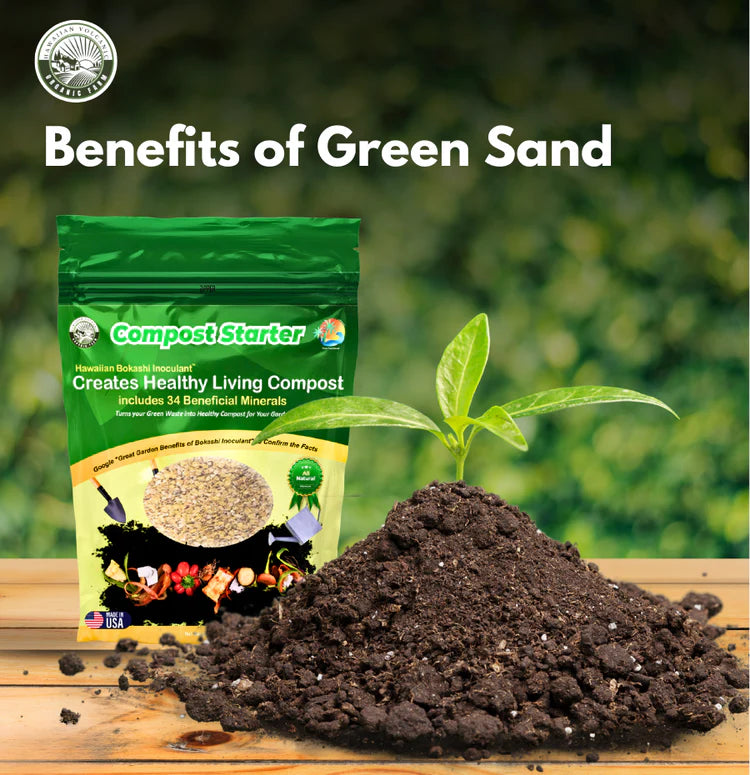
Educational Benefits of Green Sand
- Improves Soil Structure: Green sand helps in loosening clay soils and binding sandy soils, improving overall soil texture.
- Enhances Water Retention: The mineral composition aids in better water retention, reducing the need for frequent watering.
- Increases Nutrient Availability: The slow release of minerals ensures that plants receive a steady supply of essential nutrients.
- Boosts Microbial Activity: The presence of minerals supports beneficial soil microorganisms, which play a crucial role in nutrient cycling and soil health.
- Sustainable and Natural: As a naturally occurring mineral, green sand is an eco-friendly and sustainable option for improving soil fertility.
ENHANCING THE MICROBIAL ECOSYSTEM
Hawaiian Bokashi Inoculant
Benefits
- Improved Soil Structure: The microorganisms in Hawaiian Bokashi™ Inoculant help break down organic matter, such as compost or kitchen scraps, more efficiently. This decomposition process improves soil structure, making it lighter, more porous, and better able to retain moisture.
- Enhanced Nutrient Availability: Hawaiian Bokashi™ Inoculant aids in the conversion of nutrients in the soil into forms that are readily accessible to plants. The beneficial microorganisms help release locked-up nutrients, making them more bioavailable for the plant’s roots to absorb.
- Suppression of Harmful Pathogens: The introduction of beneficial microorganisms helps create an environment that is less hospitable to harmful pathogens. The beneficial microbes compete with and suppress the growth of harmful bacteria, fungi, and pests, reducing the risk of diseases.
- Increased Plant Growth and Productivity: The symbiotic relationship established between plants and beneficial microorganisms promotes healthier root development, leading to improved nutrient uptake and overall plant growth. This can result in increased yield, larger fruits or vegetables, and enhanced flowering and blooming.
- Soil Rejuvenation: Hawaiian Bokashi™ Inoculant can revitalize depleted or unhealthy soils. The addition of beneficial microorganisms helps restore microbial diversity and activity, rejuvenating the soil and promoting long-term fertility.
How it Works
Hawaiian Bokashi™ Inoculant is made by fermenting organic materials, using a mixture of wheat and rice bran, alkaline water, molasses, and a culture of effective microorganisms (EM). The EM culture contains various types of beneficial bacteria, fungi, yeasts, and other microorganisms. During the fermentation process, these microorganisms multiply and become active, creating a rich mix of beneficial microbes.
When Hawaiian Bokashi™ Inoculant is added to a grow bed or outdoor garden, it introduces a diverse community of microorganisms to the soil. These microorganisms then interact with the plant’s root system, forming a symbiotic relationship.
The microbes in the inoculant provide multiple benefits, including breaking down organic matter, suppressing harmful pathogens, improving nutrient availability, and enhancing overall soil health. They contribute to the creation of a thriving and balanced ecosystem in which plants can flourish.
What Are Beneficial Indigenous Microorganisms And How Do They Create Healthy Productive Vegetables And Fruitful Trees?
Beneficial Indigenous Microorganisms (BIMs) are microorganisms that naturally occur in a specific region or ecosystem and have positive effects on soil health, plant growth, and overall agricultural productivity. These microorganisms can include various types of bacteria, fungi, actinomycetes, and yeasts. When utilized in agriculture, they can promote sustainable farming practices and contribute to the growth of healthy and productive vegetables and fruitful trees in the following ways:
- Improved Soil Fertility: BIMs help enhance soil fertility by breaking down organic matter into nutrients that plants can readily absorb. They facilitate the decomposition of organic material, releasing essential elements like nitrogen, phosphorus, and potassium, which are crucial for plant growth.
- Nutrient Cycling: BIMs play a vital role in nutrient cycling. They help recycle nutrients in the soil, making them available to plants in a balanced and sustainable manner. This reduces the need for synthetic fertilizers and helps prevent nutrient depletion.
- Disease Suppression: Some BIMs exhibit antagonistic properties against plant pathogens. They can suppress harmful fungi and bacteria, reducing the occurrence of plant diseases and enhancing crop health.
- Increased Root Development: Certain BIMs form symbiotic relationships with plants, particularly through mycorrhizal associations. Mycorrhizal fungi attach to plant roots and extend the root system’s reach, increasing the plant’s ability to absorb water and nutrients from a larger area of the soil.
- Enhanced Stress Tolerance: BIMs can improve a plant’s ability to withstand environmental stresses such as drought, extreme temperatures, and salinity. They do this by producing stress-resistance-inducing compounds and hormones that benefit plant growth and development.
- Biodiversity Support: The use of BIMs promotes overall biodiversity in the soil ecosystem, which is essential for the long-term health and resilience of agricultural systems.
To harness the benefits of BIMs for healthy and productive vegetables and fruitful trees, farmers can adopt various practices, such as:
- Biofertilizers: Applying BIM-based biofertilizers to seedlings or directly to the soil provides a natural source of nutrients and enhances nutrient availability for plant uptake.
- Compost and Vermicompost: Incorporating BIMs into compost piles or vermicompost systems can accelerate the decomposition process and enrich the compost with beneficial microorganisms.
- Crop Rotation and Cover Crops: Employing crop rotation and cover crops can help maintain and promote BIM diversity in the soil, contributing to sustainable soil health and fertility.
- No-Till Farming: Reducing or eliminating tilling helps preserve soil structure and encourages the activity of beneficial soil microorganisms, including BIMs.
- Mulching: Mulching with organic materials can create a favorable environment for BIMs to thrive, as they feed on the decomposing organic matter.
It’s important to note that the selection of BIMs should be specific to the local environment and soil conditions. By fostering a balanced and thriving soil ecosystem with the help of beneficial indigenous microorganisms, farmers can cultivate healthier and more productive crops while reducing the reliance on synthetic inputs and minimizing the environmental impact of agriculture.
Results
By incorporating Hawaiian Bokashi™ Inoculant into a grow bed or outdoor garden, you can expect to see several positive results: a. Healthier Plants: The symbiotic relationship between plants and beneficial microorganisms supports improved plant health and vigor. Plants may exhibit stronger stems, greener leaves, and increased resistance to diseases and pests.
- Increased Nutrient Uptake: The enhanced nutrient availability facilitated by the microorganisms in the inoculant enables plants to absorb nutrients more effectively. This can lead to better overall growth, higher yields, and improved crop quality.
- Improved Soil Quality: Hawaiian Bokashi™ Inoculant contributes to the restoration and maintenance of healthy soil. It helps to build soil structure, increase organic matter content, and enhance soil fertility, resulting in long-term benefits for plant growth.
- Sustainable and Organic Approach: Hawaiian Bokashi™ Inoculant aligns with sustainable and organic gardening practices by harnessing the power of beneficial microorganisms instead of relying solely on synthetic fertilizers or pesticides.
Overall, the use of Hawaiian Bokashi™ Inoculant fosters a thriving microbial ecosystem in the grow bed or garden, promoting plant health, nutrient availability, and soil vitality. It offers a natural and effective way to establish a symbiotic relationship between microorganisms and plants, leading to numerous benefits and improved gardening results.
Hawaiian Bokashi™ Inoculant also has a Premium version that incorporates glauconite, which contains over 34 beneficial minerals. It is an organic slow-release fertilizer that contains mineral deposits from the ocean floor. This provides the beneficial microbes access to a full spectrum of additional nutrients to make bioavailable to the root systems of your plants to create healthier plants and healthier food. And all this makes “a healthier you!”
Bokashi inoculant, combined with green sand containing over 30 beneficial minerals, offers several advantages in the composting and fertilization process. Let’s explore the benefits of each component and how they work together to create a better inoculant:
Bokashi Inoculant:
- Bokashi is a fermentation process that utilizes beneficial microorganisms to break down organic matter efficiently.
- It contains a diverse mix of beneficial bacteria, yeasts, and fungi that accelerate the decomposition of organic waste.
- These microorganisms convert complex organic compounds into simpler forms, making nutrients more accessible to plants.
- Bokashi inoculant helps suppress harmful pathogens, prevent odor, and enhance soil structure.
- It increases nutrient availability, enriches the soil with organic matter, and supports plant growth and development.
Compost
How Is Bokashi Inoculant Used To Compost Kitchen Waste And What Are The Uses Of The Compost That Is Created?
Hawaiian Bokashi™ Inoculant is a type of composting aid that utilizes a fermentation process to break down kitchen waste into nutrient-rich compost. Here’s how it’s used in the composting process and the uses of the resulting compost:
- Composting Process with Hawaiian Bokashi™ Inoculant:
- Step 1: Collect Kitchen Waste: Gather organic kitchen waste such as fruit and vegetable peels, coffee grounds, tea bags, eggshells, and cooked food leftovers. Avoid adding meat, dairy, or oily items as they may disrupt the fermentation process.
- Step 2: Layering with Hawaiian Bokashi™ Inoculant: In a Bokashi composting bin or bucket, layer the kitchen waste with Hawaiian Bokashi™ Inoculant. The inoculant usually contains beneficial microorganisms, typically lactobacilli and yeast, that facilitate the fermentation process.
- Step 3: Pressing and Sealing: After adding each layer, press down the waste to remove air pockets and ensure it’s tightly packed. Once the bin is full, seal it tightly with a lid to create an anaerobic environment necessary for fermentation.
- Step 4: Fermentation: The fermentation process takes about two weeks to a month, depending on environmental conditions and the type of waste used. During this time, the beneficial microorganisms break down the kitchen waste, converting it into a pre-compost material.
- Step 5: Bury or Continue Composting: After the fermentation process is complete, the pre-compost material is not yet fully decomposed and may still be acidic. To complete the composting process, bury the pre-compost in the soil or add it to a traditional compost bin or heap. The Bokashi compost will continue breaking down into humus, enriched with nutrients.
- Uses of Bokashi Compost:
- Garden Soil Enrichment: The fully composted Bokashi material enhances soil structure and adds essential nutrients, improving the overall health of your garden soil.
- Plant Fertilizer: The nutrient-rich compost acts as an excellent natural fertilizer, supplying plants with a broad range of beneficial elements.
- Potting Mix Amendment: You can mix Bokashi compost with potting soil to provide potted plants with a nutrient boost.
- Compost Tea: Bokashi compost can be steeped in water to create compost tea, which is a liquid fertilizer that can be applied directly to plants’ roots.
- Microbial Inoculant: The beneficial microorganisms present in Bokashi compost can help establish healthy microbial populations in the soil, promoting better plant growth and disease resistance.
- Odor Reduction: Bokashi composting helps reduce foul odors often associated with traditional composting methods.
- Waste Reduction: By composting kitchen waste, you contribute to waste reduction and a more sustainable lifestyle.
Overall, Hawaiian Bokashi™ Inoculant is an efficient and convenient way to compost kitchen waste, creating nutrient-dense compost that can benefit your garden and plants while reducing the environmental impact of organic waste disposal.
Minerals
- Green sand, also known as glauconite, is a natural mineral deposit primarily composed of iron and potassium silicate.
- It contains over 30 essential minerals, including potassium, iron, magnesium, calcium, and trace elements like zinc, copper, and manganese.
- These minerals provide vital nutrients for plant growth, development, and overall health.
- Green sand enhances soil structure, promotes water retention, and improves the cation exchange capacity (CEC) of the soil.
- Cation exchange capacity refers to the soil’s ability to retain and exchange nutrients with plant roots, thereby increasing nutrient availability.
The Synergy Between Bokashi Inoculant And Green Sand:
- When Bokashi inoculant and green sand are combined, their synergistic effects enhance the overall benefits of the inoculant.
- Bokashi inoculant provides a rich microbial community that aids in the breakdown of organic matter and nutrient release.
- The diverse microorganisms in Bokashi work alongside the beneficial minerals in green sand to accelerate nutrient cycling and availability.
- Green sand, with its mineral content, enriches the compost with essential nutrients, thereby complementing the organic matter transformed by the Bokashi process.
- The increased nutrient availability from the breakdown of organic matter and the additional minerals in green sand create an optimal environment for plant growth and vigor.
In summary, the combination of Bokashi inoculant and green sand with its over 30 beneficial minerals offers multiple advantages. They work together to expedite the breakdown of organic matter, increase nutrient availability, improve soil structure, and promote healthy plant growth.
When enriching your organic garden, you have several natural fertilizing options available. One of these options is greensand, an organic slow-release fertilizer that contains mineral deposits from the ocean floor.
There are numerous benefits to using Greensand in your garden and lawn. It enhances soil structure, promotes root growth, and contributes to the overall health of plants by providing essential nutrients.
Definition and Composition Greensand, also known as “glauconite,” is a material mined from the ocean floor and used as a soil conditioner or fertilizer. It has a bluish-green color and is composed of marine potash, silica, iron oxide, magnesia, lime, phosphoric acid, and approximately 30 other trace minerals.
What Is Potash? Potash is a type of salt found in rock deposits and contains high amounts of potassium, a crucial nutrient for plant growth and reproduction. Because potash provides potassium in a water-soluble form, it is a popular ingredient in plant fertilizers.
Despite its long history, greensand remains a tried-and-true option that organic gardeners frequently rely on for soil fertilization.
Benefits Of Greensand:
- Organic Source of Potash: Greensand serves as a valuable organic potassium source, supporting overall plant health and disease resistance.
- Rich in Minerals: It is one of the best-certified organic sources of potassium and contains high levels of minerals, iron, silicates, and other trace elements.
- Improves Clay Soil: Gardeners find greensand beneficial for improving hard clay soil, enhancing its texture and nutrient content.
- Enhances Sandy Soil: Greensand is also advantageous for sandy soils as it improves moisture retention capacity. It can retain water and nutrients well, holding up to one-third its weight in water.
Safety Most gardeners agree that greensand is a highly beneficial natural fertilizer for several reasons. Notably, it is much safer to use compared to artificial fertilizers.
Greensand is perfectly safe to handle, posing no toxicity risks to humans or animals. If you have pets or children near your plants, there is no need to worry about exposing them to harmful toxins.
Additionally, greensand does not harm important microorganisms and worms in your garden soil. This is particularly valuable if you have worked hard to establish healthy soil, ensuring that your efforts won’t go to waste when fertilizing.
Usage Since greensand is not water-soluble, it needs to break down in the soil. Therefore, it should be applied directly to the soil and not mixed with water. Early spring is the optimal time for application, and the amount needed depends on the intended use.
For Trees: Use 1-2 pounds of greensand per inch of trunk diameter and spread evenly over the root zone. For Plants: Use 1-2 pounds per plant, adjusting the quantity based on size. Mix it into the top six inches of soil. For Broadcast Application: Apply between 50 and 100 pounds for every 1,000 square feet of treated soil. For Lawns: The general recommendation is to apply 16 pounds per 1,000 square feet. For Flower and Vegetable Gardens: Aim for 5-10 pounds per 100 square feet. For Bushes: Add 1/3 cup per bush when planting or fertilizing. For Potting Mix: Incorporate two tablespoons per gallon of potting mix for container gardens and houseplants. For Sensitive Plants: Greensand can be used on plants that are sensitive to other fertilizers without causing any damage. It does not burn plants like many other fertilizers.
FAQs
How Do Bacteria Digest Black Cinder Lava And Create Healthy Soil?
Bacteria play a crucial role in the process of soil formation and nutrient cycling. While lava may seem inhospitable to life, certain bacteria have adapted to thrive in such extreme environments. These bacteria possess unique capabilities that enable them to break down black cinder lava and contribute to the creation of healthy soil. Here’s a general overview of the process:
- Pioneer Bacteria: When lava flows over an area, it creates a barren, lifeless environment. However, bacteria known as pioneer bacteria are capable of colonizing these harsh conditions. These bacteria are often thermophilic, meaning they can withstand high temperatures.
- Weathering: The pioneer bacteria initiate a process called weathering, where they secrete acids and enzymes that break down the lava rocks into smaller particles. This process helps in the physical breakdown of the lava, creating a more suitable environment for other organisms to colonize.
- Organic Matter Accumulation: As the lava rocks break down, the pioneer bacteria also contribute to the accumulation of organic matter. They decompose dead organisms, including their own, releasing nutrients and organic compounds into the soil. This organic matter acts as a source of energy and nutrients for other organisms.
- Nutrient Cycling: Bacteria further contribute to soil formation through nutrient cycling. They break down complex organic compounds and release nutrients like nitrogen, phosphorus, and carbon into the soil. These nutrients are essential for the growth of plants and other organisms.
- Microbial Communities: As the pioneer bacteria transform the lava into a more hospitable environment, other microorganisms, such as fungi and archaea, join the ecosystem. These microbial communities form complex interactions that enhance soil fertility and structure.
- Plant Colonization: Once the soil becomes nutrient-rich and suitable for plant growth, pioneer plant species, often referred to as pioneer plants, start colonizing the area. These plants can tolerate harsh conditions and have mechanisms to extract nutrients from the soil.
- Succession: Over time, as the pioneer plants establish themselves, they create a more stable environment. This leads to the growth of more diverse plant species, which, in turn, attract a broader range of bacteria and other organisms. This ecological succession gradually transforms the once-barren area into a healthy, biodiverse ecosystem.
It’s important to note that the process of lava rock digestion and soil formation is a complex and dynamic interplay of various organisms and environmental factors. The specific types of bacteria involved may vary depending on the location and composition of the lava.
What Are The Benefits Of Black Cinder In Gardening?
Black cinder lava, which is a type of volcanic rock, can have several beneficial nutrients and minerals for plants and trees. Here are some of the nutrients and minerals commonly found in black cinder lava and their potential benefits for plant growth:
Silicon: Black cinder lava is rich in silicon, which can enhance the strength and structure of plants. It improves the plant’s ability to withstand biotic and abiotic stresses, such as pests, diseases, and drought.
Potassium: Black cinder lava may contain potassium, an essential macronutrient for plant growth. Potassium plays a vital role in various physiological processes, including photosynthesis, water regulation, and nutrient uptake.
Calcium: Calcium is another important nutrient found in black cinder lava. It contributes to cell wall development, root growth, and overall plant structure. Calcium is particularly beneficial for preventing disorders like blossom end rot in fruiting plants.
Magnesium: Magnesium is an essential component of chlorophyll, the pigment responsible for photosynthesis. It is crucial for energy production and aids in the absorption of other nutrients.
Trace minerals: Black cinder lava can also contain trace minerals such as iron, manganese, zinc, and copper. These minerals are essential for various enzymatic reactions, hormone synthesis, and overall plant health.
It’s important to note that the nutrient composition of black cinder lava can vary depending on the specific volcanic source and geological conditions. It’s always recommended to conduct soil tests and consult with local agricultural extension offices or horticulturists to determine the precise nutrient needs of your plants and trees and to ensure proper supplementation if necessary.
Can Hawaiian Bokashi™ Inoculant, In A Top Soil And Black Cinder Lava Mix, Create A Healthy Soil With Nutrients And Minerals That Are Bio Available For Plants And Trees?
Hawaiian Bokashi™ Inoculant is a fermented mixture of organic matter that is commonly used in composting to accelerate the decomposition process. While Hawaiian Bokashi™ composting can help break down organic material and enrich the resulting soil, it is important to understand that Hawaiian Bokashi Inoculant alone may not provide all the necessary nutrients and minerals for plants and trees.
Hawaiian Bokashi™ composting primarily focuses on the breakdown of organic matter through fermentation rather than the creation of bioavailable nutrients. The fermentation process converts the organic material into a pre-compost, but it does not necessarily convert it into readily available plant nutrients. The resulting Hawaiian Bokashi™ compost must still undergo further decomposition and conversion by microorganisms in the soil to release its nutrients.
To create a healthy soil with bioavailable nutrients and minerals for plants and trees, it is beneficial to incorporate Bokashi compost into a larger composting system or mix it with other compost materials, such as well-aged compost or vermicompost (compost produced by worms). This will provide a more balanced and diverse nutrient profile for plants.
Additionally, it is important to consider the specific nutrient requirements of the plants and trees you are intending to grow. Different plants have different nutrient needs, so incorporating other organic amendments or fertilizers may be necessary to provide a complete and balanced nutrient supply.
In summary, while Hawaiian Bokashi™ Inoculant can contribute to soil health and decomposition, it should be used as part of a comprehensive approach to soil improvement that includes other compost materials and considerations for specific plant nutrient requirements. We highly recommend that Hawaiian Bokashi™ Inoculant ™ be part of our Premium Top Soil Premium Product, which includes Hawaiian Bokashi™ Inoculant + HVO Top Soil + Black Cinder + our HVO “slow release” Organic Fertilizer
How much Hawaiian Bokashi Inoculant needed per 5 cubic yards of Top Soil and Black Cinder
The amount of dry granulated Bokashi Inoculant needed to create a healthy soil for growing vegetables in 5 cubic yards will depend on various factors, including the specific requirements of the inoculant and the condition of the existing soil.
General guidelines for using amendments in gardening. It’s common to add soil amendments, such as compost or organic fertilizers, at a rate of around 2 pounds per square yard of soil. Since you have 5 cubic yards of soil, assuming it is a uniform distribution, you can estimate the amount of Bokashi Inoculant needed based on this guideline.
For example, if you decide to use a rate of 1 pound per square yard, you would multiply 1 pound by the number of square yards in 5 cubic yards. Assuming a depth of 1 yard, you would have 5 square yards (5 cubic yards * 1 yard depth = 5 square yards). In this case, you would need approximately 5 pounds of Bokashi Inoculant.


